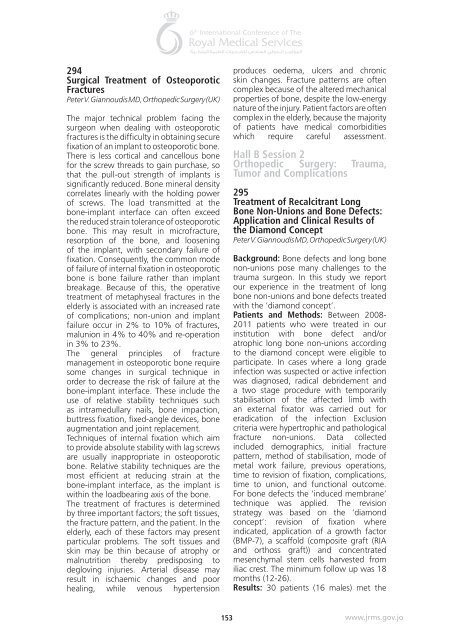Abstract book 6th RMS 16.indd
Abstract book 6th RMS 16.indd
Abstract book 6th RMS 16.indd
You also want an ePaper? Increase the reach of your titles
YUMPU automatically turns print PDFs into web optimized ePapers that Google loves.
294<br />
Surgical Treatment of Osteoporotic<br />
Fractures<br />
Peter V. Giannoudis MD, Orthopedic Surgery (UK)<br />
The major technical problem facing the<br />
surgeon when dealing with osteoporotic<br />
fractures is the difficulty in obtaining secure<br />
fixation of an implant to osteoporotic bone.<br />
There is less cortical and cancellous bone<br />
for the screw threads to gain purchase, so<br />
that the pull-out strength of implants is<br />
significantly reduced. Bone mineral density<br />
correlates linearly with the holding power<br />
of screws. The load transmitted at the<br />
bone-implant interface can often exceed<br />
the reduced strain tolerance of osteoporotic<br />
bone. This may result in microfracture,<br />
resorption of the bone, and loosening<br />
of the implant, with secondary failure of<br />
fixation. Consequently, the common mode<br />
of failure of internal fixation in osteoporotic<br />
bone is bone failure rather than implant<br />
breakage. Because of this, the operative<br />
treatment of metaphyseal fractures in the<br />
elderly is associated with an increased rate<br />
of complications; non-union and implant<br />
failure occur in 2% to 10% of fractures,<br />
malunion in 4% to 40% and re-operation<br />
in 3% to 23%.<br />
The general principles of fracture<br />
management in osteoporotic bone require<br />
some changes in surgical technique in<br />
order to decrease the risk of failure at the<br />
bone-implant interface. These include the<br />
use of relative stability techniques such<br />
as intramedullary nails, bone impaction,<br />
buttress fixation, fixed-angle devices, bone<br />
augmentation and joint replacement.<br />
Techniques of internal fixation which aim<br />
to provide absolute stability with lag screws<br />
are usually inappropriate in osteoporotic<br />
bone. Relative stability techniques are the<br />
most efficient at reducing strain at the<br />
bone-implant interface, as the implant is<br />
within the loadbearing axis of the bone.<br />
The treatment of fractures is determined<br />
by three important factors; the soft tissues,<br />
the fracture pattern, and the patient. In the<br />
elderly, each of these factors may present<br />
particular problems. The soft tissues and<br />
skin may be thin because of atrophy or<br />
malnutrition thereby predisposing to<br />
degloving injuries. Arterial disease may<br />
result in ischaemic changes and poor<br />
healing, while venous hypertension<br />
produces oedema, ulcers and chronic<br />
skin changes. Fracture patterns are often<br />
complex because of the altered mechanical<br />
properties of bone, despite the low-energy<br />
nature of the injury. Patient factors are often<br />
complex in the elderly, because the majority<br />
of patients have medical comorbidities<br />
which require careful assessment.<br />
Hall B Session 2<br />
Orthopedic Surgery: Trauma,<br />
Tumor and Complications<br />
295<br />
Treatment of Recalcitrant Long<br />
Bone Non-Unions and Bone Defects:<br />
Application and Clinical Results of<br />
the Diamond Concept<br />
Peter V. Giannoudis MD, Orthopedic Surgery (UK)<br />
Background: Bone defects and long bone<br />
non-unions pose many challenges to the<br />
trauma surgeon. In this study we report<br />
our experience in the treatment of long<br />
bone non-unions and bone defects treated<br />
with the ‘diamond concept’.<br />
Patients and Methods: Between 2008-<br />
2011 patients who were treated in our<br />
institution with bone defect and/or<br />
atrophic long bone non-unions according<br />
to the diamond concept were eligible to<br />
participate. In cases where a long grade<br />
infection was suspected or active infection<br />
was diagnosed, radical debridement and<br />
a two stage procedure with temporarily<br />
stabilisation of the affected limb with<br />
an external fixator was carried out for<br />
eradication of the infection Exclusion<br />
criteria were hypertrophic and pathological<br />
fracture non-unions. Data collected<br />
included demographics, initial fracture<br />
pattern, method of stabilisation, mode of<br />
metal work failure, previous operations,<br />
time to revision of fixation, complications,<br />
time to union, and functional outcome.<br />
For bone defects the ‘induced membrane’<br />
technique was applied. The revision<br />
strategy was based on the ‘diamond<br />
concept’: revision of fixation where<br />
indicated, application of a growth factor<br />
(BMP-7), a scaffold (composite graft (RIA<br />
and orthoss graft)) and concentrated<br />
mesenchymal stem cells harvested from<br />
iliac crest. The minimum follow up was 18<br />
months (12-26).<br />
Results: 30 patients (16 males) met the<br />
153 www.jrms.gov.jo

















